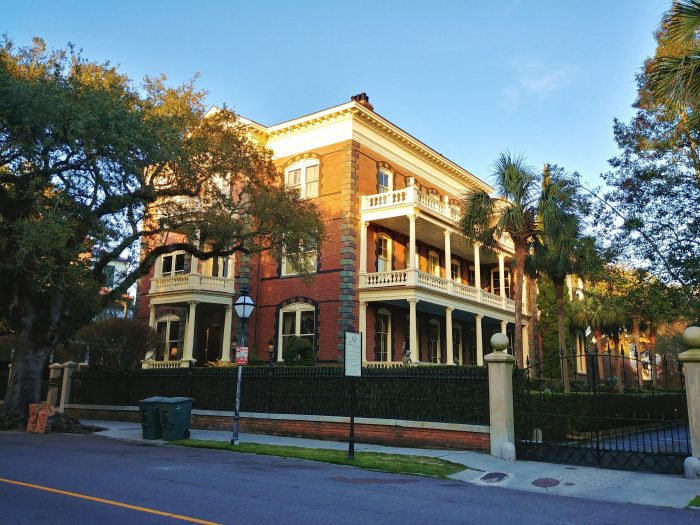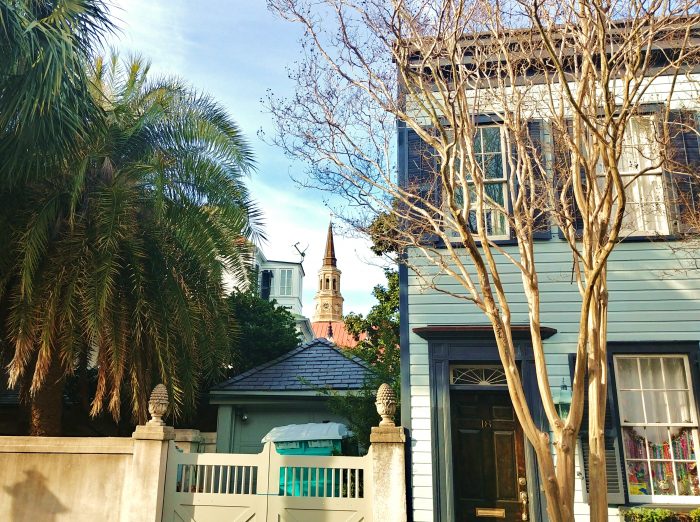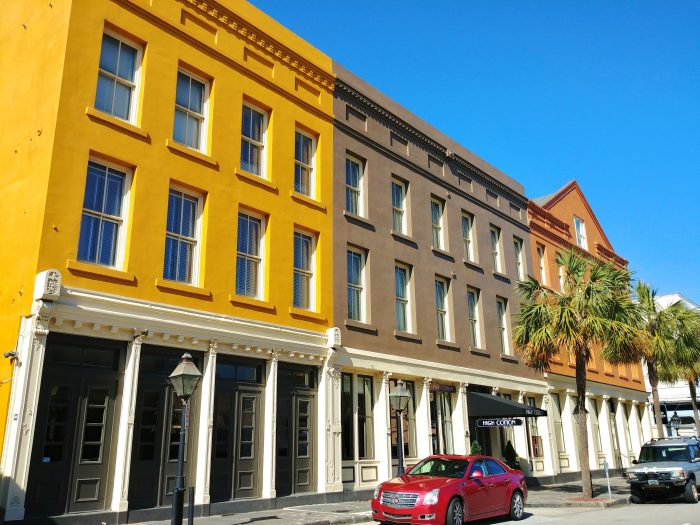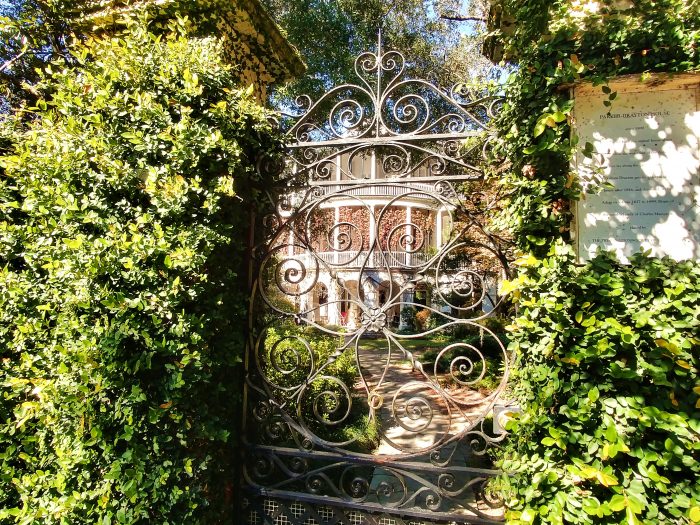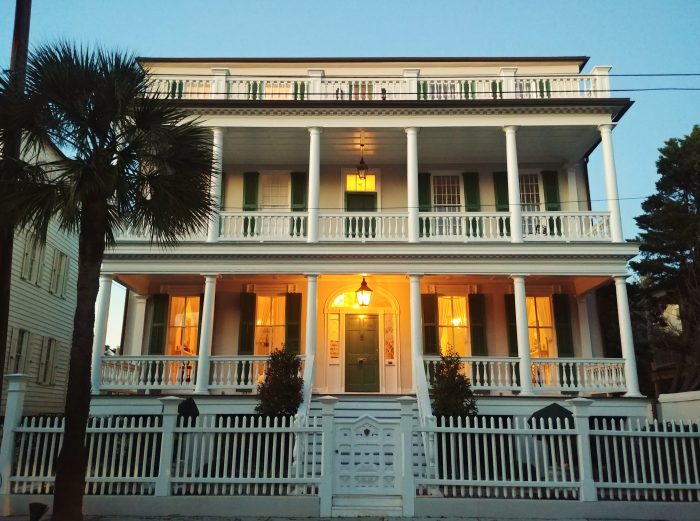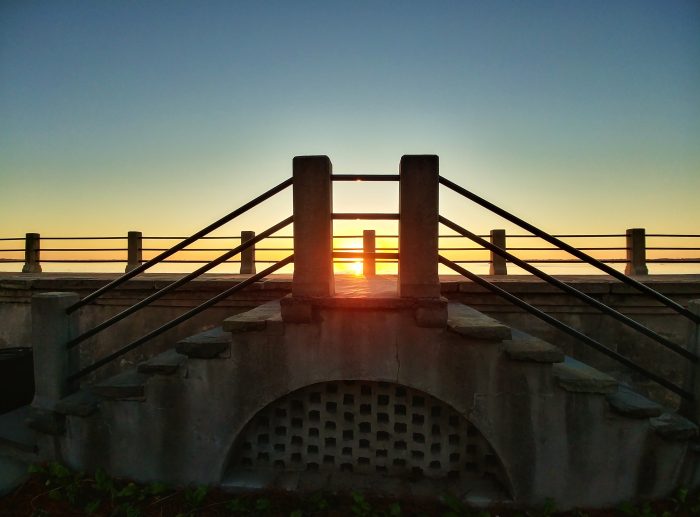Once described as the “handsomest and most complete private residence in the South,” the Calhoun Mansion (no, it is not named after John C. Calhoun) is the largest single family house in Charleston. Built in 1876, it has 35 rooms, 23 fireplaces, 14 foot ceilings and its main stairwell reaches up 75 feet to a domed ceiling. It has been beautifully restored and is now open to the public.
Oyster Point
A beautiful sunset beyond the tip of the Charleston peninsula at White Point Garden. Before gaining that name, the area was called Oyster Point, for the accumulation of oyster shells on the site. (White Point refers to the color that the oyster shells gave the area.) Have you seen the sun set from here?
Mariner’s Guide
A peek of the steeple of St. Philip’s Church, as seen from Chalmers Street. In addition to serving the church since it was added in 1848-1850, for 22 years (from 1893-1915) this steeple served as the rear tower of the set of range lighthouses used to guide sailors into Charleston Harbor. It is one of only two church steeples to have been used this way. Pretty cool.
When Being a SNOB is a Good Thing
Colorful buildings, along with wonderful restaurants, abound in Charleston. On this colorful stretch you can find the home of “High Cotton” on East Bay Street. Its sister restaurant, the wonderfully named “Slightly North of Broad,” or SNOB, is right across the street. The name SNOB is an inside Charleston joke, as South of Broad is allegedly where all the snobs live.
Charleston or Bust!
Gedney Howe, II, a prominent Charlestonian and lawyer (who was sometimes called “The Sage of the South”), was posthumously honored for his contributions to the community with this bust when the Charleston Judicial Center was built. If you’ve ever been called for jury duty in Charleston, you’ve probably had a chance to visit with him behind the historic County Courthouse at the Four Corners of Law.
The Pond
These houses, basking in the late afternoon sun, look across Rutledge Avenue to Colonial Lake (sometimes called “The Pond”). The area that the lake now encompasses was first set aside for public use in 1768, but was not developed until the mid/late 1800’s. Today the Charleston Parks Conservancy maintains the lake and the grounds — and it is an extremely popular spot for runner, walkers, shrimpers, fishermen, strollers and much more.
A House with a View
This gate/garden combinations on Gibbes Street is one of my favorite in Charleston. Built in 1806, the house was modified over the years. One thing that definitely changed was their view. After the edges of the peninsula were filled in (ultimately creating Murray Boulevard and the Low Battery), this house lost their view of the marshes and Ashley River. It’s still pretty nice there anyway!
Textures of Charleston
What a classic Charleston scene on Chalmers Street. The layers of texture is incredible. This is a great example of how stucco is used over brick to create an illusion of solidity.
Evening Light
A beautiful antebellum (built in 1835) house on South Battery lighting up as the sun starts to go down in Charleston.
Sunrise on the High Battery
The High Battery in Charleston is one of the best places to watch the sun rise. Not only do you have a clear view across Charleston Harbor to see the sun come up over Mt. Pleasant or Sullivan’s Island, you have a wonderful view of incredibly historic sites such as Fort Sumter and the aircraft carrier USS Yorktown.
- « Previous Page
- 1
- …
- 107
- 108
- 109
- 110
- 111
- …
- 188
- Next Page »
